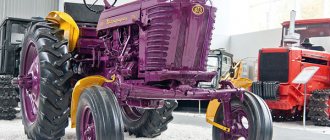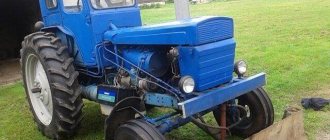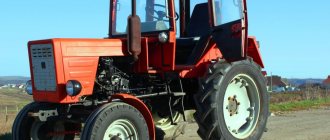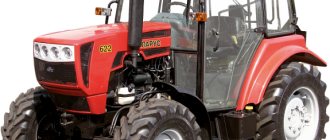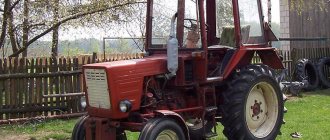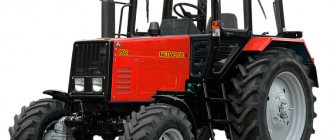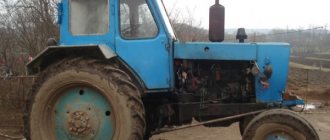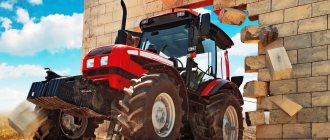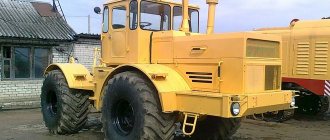The shaft can be independent or have a rotation speed dependent on the rotation of the wheels. It is possible to install additional hydraulic equipment - dumps, bucket or forklifts. The width of the rear wheels is variable. The clutch and drive also set it apart from other models. T 30 has a disc type clutch, dry. Depending on the modification - one- or two-disc. The car is all-wheel drive and has separate drive on all four wheels. Cross-country ability allows it to move confidently in the snow, overcome ditches and loose arable land without any problems.
The ground clearance of the T model is 30 – 375 mm. This is slightly smaller than other row-crop tractors, and does not always allow movement on surfaces strewn with large stones, logs, or with many large holes, for example, when working in the forest. However, it is quite suitable for ordinary work in a village or city.
The technical characteristics of the all-wheel drive T-30 are not everything. From the very beginning of its production in the 70s, tractor drivers fell in love with this machine for its excellent ergonomics. How important is it?
Even now this tractor is one of the most convenient. The tractor cabin was heated, was well protected on all sides, and had a one-piece monolithic frame that would keep the tractor driver safe in the event of a rollover. The cabin glazing covered more than 90% of the area and provided an excellent panoramic view. It had power steering and convenient control mechanisms.
T25 tractor rear tire size
TRACTOR WHEELS AND PNEUMATIC TIRES OF THE T-25 TRACTOR
Rear drive wheel of the T-25 tractor
The rear drive wheel consists of a stamped steel disk, a profiled rim and a low-pressure tire. The tire cover has lugs on its outer surface, the size, shape and location of which ensure good adhesion of the tire to the soil and self-cleaning of the tire from dirt during operation. There is an arrow on the side surface of the tire that indicates the direction of rotation of the tire when it is installed on the tractor. Incorrect installation of the spike accelerates its wear and leads to rapid sticking when working on wet soil. Therefore, when installing the drive wheels on the tractor, you must ensure that the direction of rotation of the tire coincides with the arrow on the tire (the ends of the lugs must converge in the direction of rotation of the tire). When reconfiguring the tractor for long-term operation in reverse, be sure to swap the right and left wheels.
In the T-25S1 modification, drive wheel tires measuring 240–813 mm (9–32″) are installed on the tractor. The small width of these tires makes it possible to use the tractor for inter-row cultivation with the necessary protective zone.
A rubber tube with a water-air valve and a tire cover are placed on the rim. On the inner surface of the rim there are six welded posts to which the wheel disc is secured using carriage bolts. The convex part of the disk is attached to the flange of the rear wheel axle with bolts with cone heads. By turning the rim of the drive wheel relative to the disk and changing the position of the disk relative to the flange of the drive wheel axis, the tractor track is adjusted within the range of 1100-1500 mm.
In the T-25 C2 modification, drive wheel tires measuring 270–711 mm (10–28″) are installed on the tractor. The use of such tires increases the traction power of the tractor, reduces soil compaction and allows you to hang heavier machines and implements (sprayers, loaders, etc.) weighing up to 575 kg on the tractor.
Tires measuring 10–28″ are wider than tires 9–32″, and therefore their use in inter-row cultivation of row crops is limited. They are intended primarily for transport work and general agricultural work. A tire rim measuring 10-28″ has four posts with which it is attached to the rim. The tractor track with 10-28″ spikes is adjusted in the range of 1200-1470 mm.
The air pressure in the tires of the drive wheels should be 0.8-0.9 kg/cm2 for field work, and 0.9-1.2 kg/cm2 for transport work. When the tire pressure decreases to 0.8 kg/cm2, the compression of the cylinder from the weight of the tractor increases and the contact area of the tire with the soil increases, which increases the traction of the tractor and reduces its slipping on soft soil. As the tire pressure increases, its load capacity increases. The maximum permissible pressure for a 9-32″ tire is 2 kg/cm2.
To increase the adhesion weight of the tractor, water is poured into the tire chambers of the driving wheels through a water-air valve to 3/4 of the chamber volume (40-45 kg) and air is pumped to a pressure of 0.8-0.9 kg/cm2.
Source
Tires for the T25 tractor: features of selection taking into account the conditions of use
Tires for the T25 tractor can be different, as well as the conditions in which they are used.
Tires for the T25 tractor must match their equipment and be just as reliable; for this, the tires must be selected correctly, taking into account the conditions in which they will be used.
If tires for the T25 tractor will be used in winter (for example, for snow removal), they must have traction on icy surfaces, which is ensured by the characteristic large tread pattern.
This tractor is also used for construction purposes: the ground under the wheels on a construction site is not always dry and hard, it can be washed out and very difficult to drive on; of course, such conditions require special tires for the T25 tractor.
Also, the T25 tractor can be used on a regular asphalt road; to work on such a surface you need regular, universal tires with puncture protection.
To summarize, we can conclude: in order to buy tires for the T25 tractor, you need to decide on the place of its use, this will allow you to maximize the capabilities of the tires, which will ensure reliable and efficient operation of the tractor.
Acceptable tire sizes for rear wheels: 12.4-28, 240-813mm (9.5-32″), 270-711mm (10-28″).
Acceptable tire sizes for front wheels: 170-406 mm (6-16”), 150-406 mm (5.5-16”)
You can buy tires for the T25 tractor in our online store by placing an order for the product of your choice, after which our operator will contact you and clarify the details of the order.
If you don’t know which tires to buy for the T25 tractor, our highly qualified specialists will help you with the choice by calling the phone number listed on the website.
The product is delivered throughout Moscow and throughout Russia.
Source
Design of the rear drive wheels of the T-25 tractor
The rear wheel consists of a stamped steel disk with a profiled rim and a tire inside. Their outer surface is equipped with a special tread (a convex pattern on the outside of the wheel), which ensures good grip of the wheels on the soil.
This is interesting! The tread also ensures self-cleaning of the tire.
It is imperative to pay attention to the side surface of the tire, because it is on it that the guide arrow is located. It indicates the correct direction of wheel rotation, which must be taken into account when mounting the wheels.
If the wheels are installed incorrectly, this will lead to:
1. Deterioration of the adhesion process to the surface; 2. Premature wear.
Therefore, do not be lazy, spend a couple of seconds before starting tire fitting work.
Technical characteristics of the rear wheels for various modifications
At the moment, there are two modifications of the T-25 tractor: C1 and C2, and they use different sizes.
Wheel size 240/813 mm, excellent for use in inter-row cultivation of various crops. A special chamber with an air intake valve and the wheel itself are attached to the rim. The inner surface is equipped with 6 welded racks, to which the disk is attached with bolts. The convex part of the disk is attached to the axle flange, also using bolts with tapered supports. I use the rotation of the rim relative to the disk and by changing its position relative to the flange, you can adjust the track width from 110-150 cm.
The tire size used is 9-32 inches. This makes it possible to increase the traction power of the machine and reduce possible soil compaction.
Important! Using the 10-28 inch size allows the use of heavier attachments weighing up to 600 kg.
However, please note that they are not suitable for use in inter-row cultivation of fields. Their main purpose is general transport, loading and traction work.
Hydraulics, electrics and attachment system
Hydraulics ensure the operation of towed devices and the raising and lowering of attachments. The system includes an oil tank, a pump, an oil line, one or more power cylinders and a hydraulic distributor.
The tractor uses a single-wire electrical system with a voltage of 12V. It is equipped with sensors for temperature, oil level, voltage, speed, etc.
The equipment has a special mechanism that is used to attach attachments. With its help, you can raise devices for transportation and lower them during work. The hitch system is a classic three-point one. Consists of connecting chains, a central rod and two longitudinal rods. Attachments are mounted on the free ends of both rods.
Despite the outdated design, T-25 tractors continue to be the standard of reliability and performance with a simple design and small dimensions. The equipment continues to be widely used in the CIS countries when carrying out various field, economic and other works.
Rear wheels of tractor T-25
TRACTOR WHEELS AND PNEUMATIC TIRES OF THE T-25 TRACTOR
Rear drive wheel of the T-25 tractor
The rear drive wheel consists of a stamped steel disk, a profiled rim and a low-pressure tire. The tire cover has lugs on its outer surface, the size, shape and location of which ensure good adhesion of the tire to the soil and self-cleaning of the tire from dirt during operation. There is an arrow on the side surface of the tire that indicates the direction of rotation of the tire when it is installed on the tractor. Incorrect installation of the spike accelerates its wear and leads to rapid sticking when working on wet soil. Therefore, when installing the drive wheels on the tractor, you must ensure that the direction of rotation of the tire coincides with the arrow on the tire (the ends of the lugs must converge in the direction of rotation of the tire). When reconfiguring the tractor for long-term operation in reverse, be sure to swap the right and left wheels.
In the T-25S1 modification, drive wheel tires measuring 240–813 mm (9–32″) are installed on the tractor. The small width of these tires makes it possible to use the tractor for inter-row cultivation with the necessary protective zone.
A rubber tube with a water-air valve and a tire cover are placed on the rim. On the inner surface of the rim there are six welded posts to which the wheel disc is secured using carriage bolts. The convex part of the disk is attached to the flange of the rear wheel axle with bolts with cone heads. By turning the rim of the drive wheel relative to the disk and changing the position of the disk relative to the flange of the drive wheel axis, the tractor track is adjusted within the range of 1100-1500 mm.
In the T-25 C2 modification, drive wheel tires measuring 270–711 mm (10–28″) are installed on the tractor. The use of such tires increases the traction power of the tractor, reduces soil compaction and allows you to hang heavier machines and implements (sprayers, loaders, etc.) weighing up to 575 kg on the tractor.
Tires measuring 10–28″ are wider than tires 9–32″, and therefore their use in inter-row cultivation of row crops is limited. They are intended primarily for transport work and general agricultural work. A tire rim measuring 10-28″ has four posts with which it is attached to the rim. The tractor track with 10-28″ spikes is adjusted in the range of 1200-1470 mm.
The air pressure in the tires of the drive wheels should be 0.8-0.9 kg/cm2 for field work, and 0.9-1.2 kg/cm2 for transport work. When the tire pressure decreases to 0.8 kg/cm2, the compression of the cylinder from the weight of the tractor increases and the contact area of the tire with the soil increases, which increases the traction of the tractor and reduces its slipping on soft soil. As the tire pressure increases, its load capacity increases. The maximum permissible pressure for a 9-32″ tire is 2 kg/cm2.
To increase the adhesion weight of the tractor, water is poured into the tire chambers of the driving wheels through a water-air valve to 3/4 of the chamber volume (40-45 kg) and air is pumped to a pressure of 0.8-0.9 kg/cm2.
Technical characteristics of the T-4A tractor
Despite the early years of design and the start of production, the T-4A tractor is a real hero in its class. Its technical characteristics are truly outstanding. Even in comparison with modern analogues existing today, it continues to look quite impressive.
Dimensional and mass indicators
Let's consider the mass and dimensional indicators of this equipment - this will allow us to imagine it in operation and evaluate its ease of use in various conditions:
- fuel tank volume, l – 320;
- width of the created track, mm – 1384;
- longitudinal base length, mm – 2,522;
- ground clearance, mm – 340;
- width of the shoes used in the design, mm – 420;
- the value of pressure on the soil, MPa – 0.04.
Overall dimensions of the body itself:
- length from the rear of the tracks to the front edge of the body, mm – 4,684;
- width from the edges of the tracks, mm – 1,952;
- height from the bottom of the tracks to the top of the cabin, mm – 2,545.
The structural weight with all filling fluids is 8,145 kg. Many people consider the tractor to be clumsy due to its heavy weight. But thanks to its powerful engine, it can easily cope with its work even on the hardest soils! The T-4A tractor will prove to be a real hard worker in any conditions.
Engine
The tractor used a real giant compared to other engines - the A-01 diesel engine. Its performance parameters are truly outstanding even today, decades after its launch.
There are three different modifications of the motor. All of them were used in the T-4A tractor at various periods of time:
- A-01MSI-1;
- A-01MRSI-1;
- A-01MKSI-1.
Their performance characteristics, despite different markings, are similar to those of their siblings:
- motor type – four-stroke;
- total number of cylinders, pcs. – 6;
- cylinder arrangement – vertical/in a row;
- The cylinders operate in the following order: 1/5/3/6/2/4;
- cylinder diameter, mm – 130;
- piston stroke, mm – 140;
- rated power value, hp – 135;
- rated crankshaft rotation speed, min-1 – 1,700.
Transmission
The “strong” part of the tractor is its box. It is a manual transmission, which is equipped with a reverse gearbox. There are 4 speeds for reverse and 8 speeds for forward movement. In fact, this box is similar to that used on its predecessor, the T-4 tractor. It hasn't been modified.
Chassis (transmission)
The chassis, like the gearbox, was completely inherited from its predecessor. Its main components are:
- two special track chains;
- special balancing spring – stabilizes the tractor on steep slopes and prevents it from overturning;
- two caterpillar carts.
Cabin and tractor controls
Initially, the tractor cabin was made of metal and was insulated to a minimum. Subsequently, many modernizations were carried out. All this together made it possible to achieve more or less acceptable working conditions for the driver. Although it was far from comfortable. The T-4A tractor is a machine for real men! The cab is heated and has a fan/dust separator. There is a passenger seat.
The machine was controlled using several levers for various purposes. Gear shifting was carried out using a dry clutch - it was activated by a special pedal. All sensors located on the dashboard were used only of the analog type - even on models produced in the last years of ATZ's existence.
Rear wheel arrangement of the T-25 tractor
The driving rear wheel of the T-25 tractor contains low-pressure tires and a steel disk with a profiled stamped rim. The outer surface of the tire is equipped with a tread pattern that ensures self-cleaning of the tire during operation and maximum traction between the wheel and the soil. There is an arrow on the outer surface of the side tire that shows the direction of rotation of the wheel when the tire is installed on the tractor. If the tire is installed incorrectly on the wheel, the tire may wear out quickly.
Therefore, it is necessary to be careful when installing the tire on the rear wheel and ensure that the arrow coincides with the direction of rotation of the wheel. If the tractor is used for long periods of work in reverse, it is necessary to replace the positions of the right and left wheels. For modernization on the T-25 C1 tractor, tires are installed on the rear wheel, the size of which is from 240 to 813 mm, which will make it possible to use the T-25 tractor for processing between rows of agricultural crops
A rubber tube is placed on the rim of the rear drive wheel of the T-25 tractor, which has a water-air valve and a tire. The inside surface of the rim is equipped with six welded posts, to which the wheel disc is attached with bolts. The disk with its convex part is attached to the flange of the drive wheel axle using bolts that have conical supports. By changing the position of the disk in relation to the flange of the rear wheel axle, as well as turning the rim of the drive wheel in relation to the disk, the tractor track width is adjusted within the range of up to 1500 mm.
To modernize the T-25 C2 tractor, tires are used for the rear wheel, the size of which is from 270 to 711 mm. When using these tires, the traction power of the tractor is improved, soil compaction is reduced and it becomes possible to equip the heaviest mounted machines (sprayers, loaders) weighing up to five hundred and seventy-five kilograms. However, it should be noted that such tires are not intended for use of the T-25 tractor when cultivating between rows of agricultural crops. They are often intended for tractors that perform general and transport agricultural work.
The air pressure in the tires of the rear wheel during field work should be up to 0.9 kg/cm², and when transporting loads up to 1.2 kg/cm². If you reduce the tire pressure to 0.8 kg/cm², there will be an increase in the contact area of the tire with the soil, resulting in an increase in the traction qualities of the tractor with a decrease in wheel slipping on soft soil. To increase the load capacity, the tire pressure must be increased. The highest pressure allowed in rear wheel tires is 2 kg/cm².
T-25 capabilities
The design of the T-25 allows you to adapt the vehicle to specific needs. For example, changing the track width, which allows you to work on any fields and farms. Changing the agrotechnical clearance will allow the tractor to be used on slopes.
The tractor can move during operation both in reverse and forward. It is also possible to set up the machine for long-term operation in reverse. The drive pulley installed on the T-25 opens up the possibility of connecting stationary equipment and machines. An additional brake cylinder will allow the use of a semi-trailer.
Source
Technical characteristics of the rear wheels for various modifications
At the moment, there are two modifications of the T-25 tractor: C1 and C2, and they use different sizes.
Wheel size 240/813 mm, excellent for use in inter-row cultivation of various crops. A special chamber with an air intake valve and the wheel itself are attached to the rim. The inner surface is equipped with 6 welded racks, to which the disk is attached with bolts. The convex part of the disk is attached to the axle flange, also using bolts with tapered supports. I use the rotation of the rim relative to the disk and by changing its position relative to the flange, you can adjust the track width from 110-150 cm.
The tire size used is 9-32 inches. This makes it possible to increase the traction power of the machine and reduce possible soil compaction.
Important! Using the 10-28 inch size allows the use of heavier attachments weighing up to 600 kg.
Cabin structure
The equipment was produced in different modifications, so individual components underwent significant changes. The standard design drawing for the T-25 tractor included a glass-enclosed steel cabin. Heating came from hydraulics, the steering column and seat were adjustable. Structures with an awning and a safety cage were also produced. At the same time, both versions provided for the possibility of using a full-fledged cabin. The glass sizes in the T-25 tractor also changed depending on the type of cab.
The shape of the pedals is classic. The brake pedals are connected using a separate bar. Next to the seat on the left side is the differential control pedal. The gear shift and reverse lever is located almost in the middle of the cabin. A table with a drawing of the lever switching is attached to the tool box. On the right side there is a lever for fuel and control of the power take-off shaft. To the right of the steering column there are control levers for the hydraulic linkage, base and remote hydraulic cylinder. All levers with 4 positions.
Further development of the tractor
The following year, 1973, the Vladimir Tractor Plant launched production of a new modification of this agricultural machine under the symbol 25A, which differed from the previous one in the presence of a cabin and slightly increased engine power. In terms of the number of cars produced, the model with the “A” index was a real record holder: over the years of production, a total of 731,700 units were produced against 99,000 cars of the previous modification.
The subsequent modification with the index “A3” was the final one for the tractor model we are describing. Its distinctive feature was the appearance of a safety cage, so VTZ made only a small technical tuning of the T-25 tractor.
Although the “Vladimirets” today can be called an outdated machine, which is being replaced by new models, including its direct descendants, produced by the same VTZ, however, in the endless fields and expanses of our country, this equipment is found everywhere. That is why the question of where to get tires for the T-25 tractor is more than relevant, although they are sold by many domestic stores. However, even despite the widespread availability of rubber for this type of tractor, let us remind you that following a few simple rules will allow you to significantly extend their life.
Price of tractor T-25A
Price
What makes the T-25A tractor very competitive on the market is its price. It is an order of magnitude cheaper than other models with similar characteristics. The price and wide capabilities of the model give it an advantage over its competitors in this class of specialized equipment.
The price of the T-25A tractor fully corresponds to its quality. The price mainly depends on several factors. Before choosing, you need to decide on the model, and before that you need to clearly understand for what purposes you will use this technique. You should also decide what additional equipment will be installed in the future.
Important Review of the best Hitachi excavators
The average market price of used tractors fluctuates around 60,000-300,000 rubles. It all depends on the year of release of the equipment, modifications and availability of additions.
What wheels will fit on the T25 without altering the rim. Page 11 of 18
Please tell me the model is not visible in the photo?
Please tell me the model is not visible in the photo?
tires 420/70 R28 model I-428. Manufacturers include VOLTYRE and MEDVED.
Please tell me the model is not visible in the photo?
tires 420/70 R28 model I-428. Manufacturers include VOLTYRE and MEDVED.
my eyes are afraid, my hands are out of my ass, but I don’t give up ツ
And it’s better to have reinforced discs for them, where the plate is screwed on with 8 bolts.
Please tell me the model is not visible in the photo?
tires 420/70 R28 model I-428. Manufacturers include VOLTYRE and MEDVED.
I can’t say, because... My buddy and I have Volture. The bear only saw it on Avito, they sold it for 20 thousand per tire.
Please tell me the model is not visible in the photo?
tires 420/70 R28 model I-428. Manufacturers include VOLTYRE and MEDVED.
I can’t say, because... My buddy and I have Volture. The bear only saw it on Avito, they sold it for 20 thousand per tire.
I just know VOLTURA but the bear hasn’t heard
my eyes are afraid, my hands are out of my ass, but I don’t give up ツ
Please tell me the model is not visible in the photo?
tires 420/70 R28 model I-428. Manufacturers include VOLTYRE and MEDVED.
I can’t say, because... My buddy and I have Volture. The bear only saw it on Avito, they sold it for 20 thousand per tire.
I just know VOLTURA and the bear didn’t hear [image]
There was an ad on Avito, either in Volgograd or in Vladimir, there is a mountain of these tires in the photo, and MEDVED is written on them, I myself saw tractor tires of this brand for the first time. I didn't have a chance to touch it live.
And it’s better to have reinforced discs for them, where the plate is screwed on with 8 bolts.
My all-wheel drive had 4-bolt wheels. There were no problems, although I only drove them for about six months.
Please tell me the model is not visible in the photo?
tires 420/70 R28 model I-428. Manufacturers include VOLTYRE and MEDVED.
I can’t say, because... My buddy and I have Volture. The bear only saw it on Avito, they sold it for 20 thousand per tire.
I just know VOLTURA and the bear didn’t hear [image]
There was an ad on Avito, either in Volgograd or in Vladimir, there is a mountain of these tires in the photo, and MEDVED is written on them, I myself saw tractor tires of this brand for the first time. I didn't have a chance to touch it live.
Thanks, I'll ask around in stores.
my eyes are afraid, my hands are out of my ass, but I don’t give up ツ
And it’s better to have reinforced discs for them, where the plate is screwed on with 8 bolts.
My all-wheel drive had 4-bolt wheels. There were no problems, although I only drove them for about six months.
I've already welded 4-bolt discs for two people, the rim starts to tear on them in the places where the lugs are welded to which the plate is screwed. Of course, it may also be the tractor drivers’ fault, they didn’t look after the bolts and didn’t tighten them on time.
Of course, it may also be the tractor drivers’ fault, they didn’t look after the bolts and didn’t tighten them on time.
Please tell me the model is not visible in the photo?
tires 420/70 R28 model I-428. Manufacturers include VOLTYRE and MEDVED.
I can’t say, because... My buddy and I have Volture. The bear only saw it on Avito, they sold it for 20 thousand per tire.
I just know VOLTURA and the bear didn’t hear [image]
There was an ad on Avito, either in Volgograd or in Vladimir, there is a mountain of these tires in the photo, and MEDVED is written on them, I myself saw tractor tires of this brand for the first time. I didn't have a chance to touch it live.
Thanks, I'll ask around in stores. [image]
This is what the medved tire looks like, just from that ad photo https://55.img.avito.st/640×480/1822640555.jpg
What is the tire size on the T 25 tractor?
Front wheel tire size is 150–406 mm or 5.5–16″, where the first number is the tire width and the second number is the fit size. Since 1971, the T-25 tractor has been equipped with a size of 170–406 mm, or 6–16″. The driving wheel tires in the C1 modification are 240-813mm or 9-32″, which allows the tractor to be used for inter-row cultivation. The C2 modification has drive wheel tires of 270–711 mm or 10–28″. Installing such tires increases the traction power of the tractor.
Why doesn't the front axle turn in one direction on the T 40 tractor?
If on the T-40, with the clutch completely disengaged, the front axle does not engage in one direction, it means that the adjustment of the locking mechanism is incorrect. It needs to be adjusted again.
We shift the gearbox to neutral and release the main clutch pedal. That is, we leave the clutch on.
Unsplit the fork pin and remove it from the locking lever.
We press the locking lever and move it to the rearmost position so that it corresponds to the engaged position of the clutch.
We unscrew the fork and select the length of the rod so that when the lever is in the rearmost position, the rod can be connected.
After this, we pin the fork pin.
How does wheel size affect fuel consumption?
The larger the wheels (including the width of the rims and tires, as well as the diameter of the rim itself), the more the wheels, and therefore the car itself, weigh. A larger weight requires a larger moment of inertia because the motor requires more force to produce the angular acceleration of the wheel. The larger the wheel size, the larger the lever arm, which means, again, more torque is needed to accelerate the wheel and, accordingly, the car, which increases fuel consumption.
